What to Look for in a Guitar Amp

The world of amplifiers, similar nearly hi-fi equipment, is ruled past electric wizardry. It'due south where excursion boards, tubes and wattage come to play, and where words such equally "warm," "sparkly," and "nighttime" are chanted like prayers. To someone starting out on the instrument, this world can be hostile and impenetrable. Which is where we come up in.
Amplifiers are every bit—some would argue more than—important in shaping your audio equally the guitar itself. Just in that location'southward no need to burrow into that debate. Instead, when shopping for an amp, judge them on these 3 factors: tone, power, and features.
Oh, and if you're trying one out at a store, call back to lug your guitar forth. That'due south the best way to find a expert lucifer and swipe right.
Tone
A great amp can make a modest guitar punch well to a higher place its weight; a bad amp volition transform a top-shelf axe into a deal bin sitter. The first thing y'all take to decide is the type of amp that best fits your needs. And there are four to cull from: tube, solid-state, hybrid and digital.
The anatomy of amplification
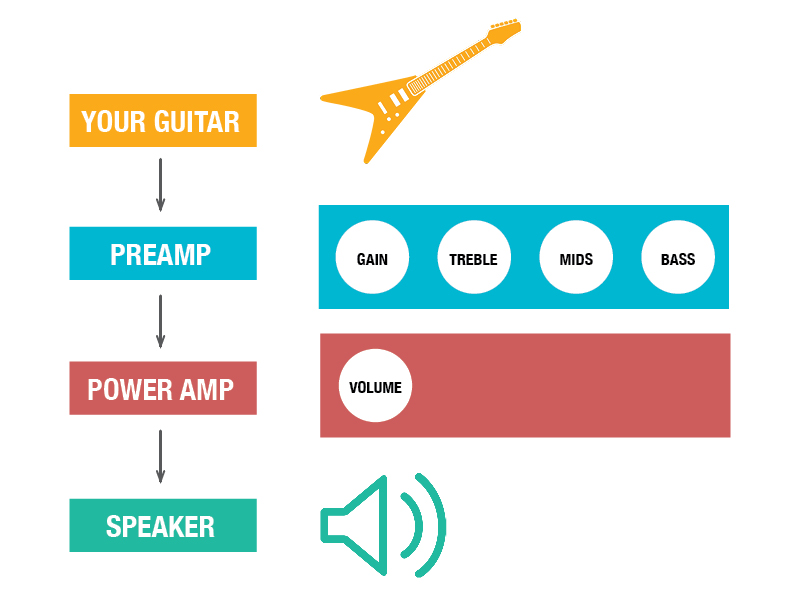
Before diving into all that, even so, it helps to sympathise just how the indicate flows from your guitar's pickups to your ears.
When you hook your guitar upward to an amp, y'all're plugging it into its preamp. That's the component that takes the signal from your instrument and, through the "Bass," "Middle," and "Treble" controls, processes it. One time the preamp has done its job, the signal is channeled into the power amp. Here, the 'real' amplification occurs; the power amp boosts the bespeak and sends information technology to the speakers, which in plow convert the bespeak into sound. In simpler terms, the preamp shapes your sound while the power amp determines its strength.
You might have seen "Proceeds" and "Volume" knobs on many amps and wonder about the departure. Remember of the former as the input level and the latter as the output level—and information technology's an important distinction when discussing tube amps.
Tube and valve amps
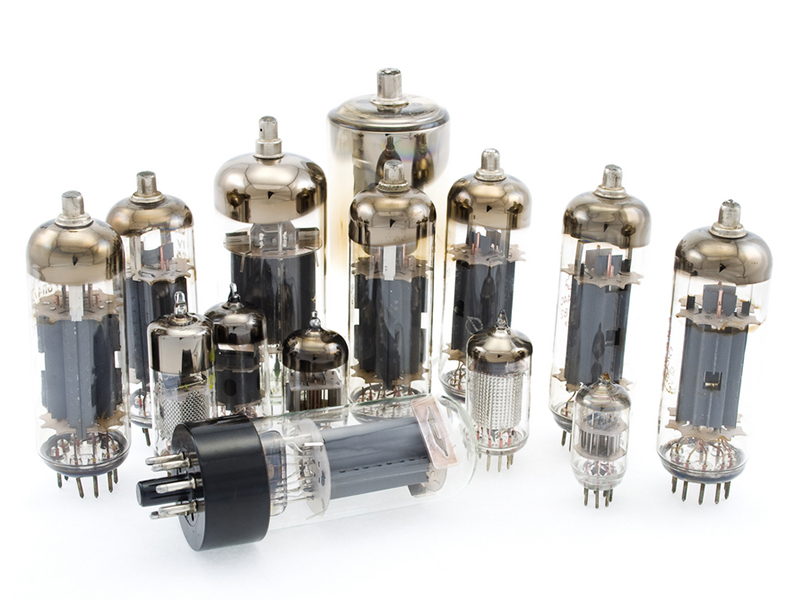
Many High Priests of Tone consider these the holy grail of guitar distension. And, in the correct easily, they may very well exist. Tube amps (or more accurately, all-tube amps) have vacuum tubes in both the preamp and power amp stages that boost signals. Don't worry about how they do that for at present.
The consensus about tube amps is that they are more responsive—so playing with a light or heavy touch will yield different tones—and offer a smoother, 'fatter' sound that lends heft to your playing. But the foremost reason guitarists prefer tube amps is their natural distortion. If y'all crank up the gain only keep the book low, you're forcing the tubes to piece of work harder than what they were designed to do. The result? A gritty, saturated overdrive that, perhaps considering of its unpredictability, has been cherished for decades.
That said, there are just as many snags with tube amps. They're heavy, notoriously expensive and they require regular maintenance. And if you're new to the instrument, you probably won't exist able to exploit a tube amp'due south quirks—it'll audio similar a very ordinary solid-country amp.
Solid-country amps

In identify of tubes, these guys rely on transistors to amplify signals. Many believe that transistors don't offering the subtlety and responsiveness of tubes, and that taking them to breaking bespeak results in a thinner, or harsher, distortion. Just that difference is negligible to untrained ears. And many genres—metallic, for instance—would benefit more from the consistent 'chugga-chugga' that a practiced solid-land tin can produce.
Solid-state amps are about e'er lighter and cheaper than their tube siblings, and require shut to nothing maintenance. So it'south no surprise that well-nigh beginners start out with one of these.
Digital and modeling amps
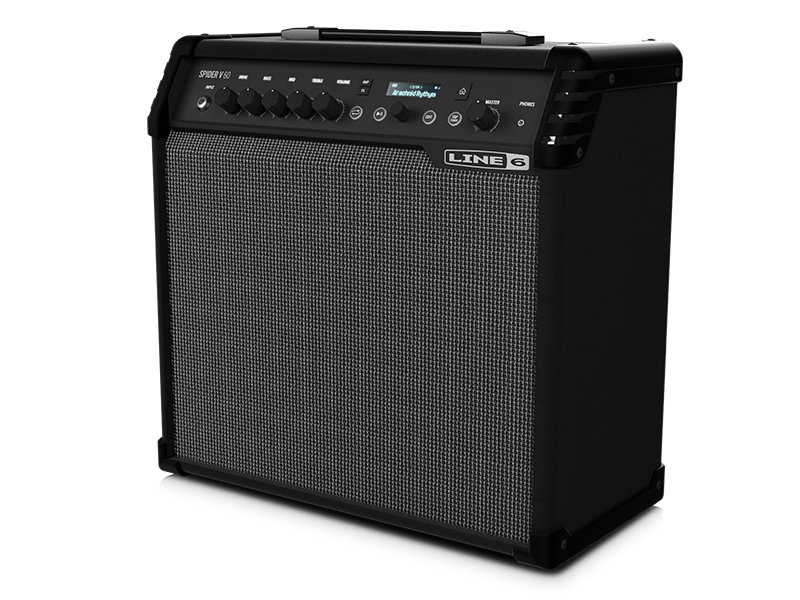
There are those who have no qualms shelling out thousands for an accurate mid-century Fender amp because nothing else, to them, sounds remotely close. That may have had a smidgen of truth a decade ago, but the digital or modeling amps today take come up a long mode in replicating those time-honored tones.
Rather than tubes or transistors, these machines use digital engineering science in the preamp stage to simulate the legendary amps of yore. And depending on the model you're looking at, digital amps tin even mimic speakers, which gives y'all a wealth of mix-and-match combinations to cull from.
The downside of modeling amps is their steep learning curves. Dialing in a tone that pleases your ears can have hours of fiddling with buttons labeled with arcane terminology, hours that could instead be spent on your instrument.
Hybrid amps
This can hateful i of two things: Either the amp's half tube and half solid-land, or information technology has a digital modeling preamp and a tube power amp. The vast majority of the one-time just employ tubes in their preamp stages, meaning you can force them to 'break up' similar you lot would an all-tube amp. But don't think of these every bit a 'best of both worlds' deal—more like 'Jack of all trades.'
Ability
Every guitarist wants to command a phalanx of gargantuan speakers. Unless you're planning to fill a stadium, or you alive v miles from your closest neighbor, that isn't the all-time idea. That ready-upward needs to be tear-the-roof-off loud to sound any proficient.
So before yous make the call on the amp to bring home, decide what you'll be using it for and where you'll exist using information technology. Once you've settled that, y'all can starting time sifting through wattages, configurations and speaker sizes—those are the disquisitional factors you should consider.
Wattage
Wattage is the measurement of an amp's power output, but they're non on an accented scale. A five-watt tube amp tin exist louder than a 20-watt solid-state, for instance. And so while it's satisfying to avowal about your new 100-watter, the reality is that a bigger number isn't necessarily louder, or better.
Configuration

There are only two configurations: combos and separates. The former packs in the 'head' (that's the preamp and power amp) and speaker cabinet into a unmarried box, while the latter comes every bit—you lot guessed information technology—separate parts. It's a trade-off between portability and flexibility.
At that place are as well rackmount preamps and ability amps, which grant you even more freedom to marry discrete components. However, doing then can be daunting, and we wouldn't recommend newbies go downwardly this path.
Speaker sizes
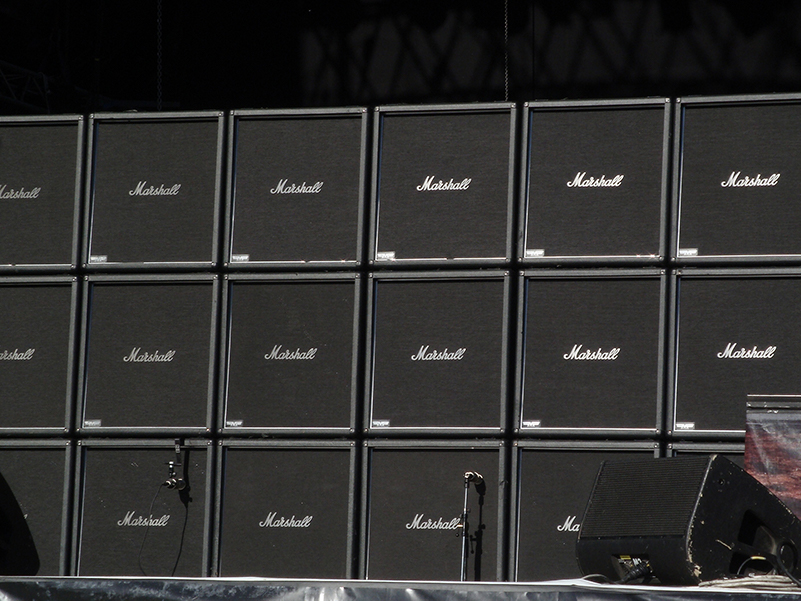
These are measured in inches by diameter, with common sizes being viii, x and 12 inches. The rule of thumb hither is that larger speakers issue out stronger bass notes, and smaller ones are better at handling the college frequencies. When you meet terms similar "4×12," information technology simply means the number and size of speakers in a cabinet—in this instance, it's iv 12-inch speakers.
One-half-stacks and full-stacks refer to the number of cabinets. The former has one, and the latter two or more. These are monstrous, heavy beasts that are best suited for gigging or rehearsing with a ring.
And then how do they all add up?
Flat dwellers and sleeping accommodation rock stars should stick to small combo amps—anything between v to twenty watts should suffice. Simply if you lot're really short on real estate, consider desktop or mini amps instead. They're about the size of your boilerplate Bluetooth speaker, and many can even run on batteries. No guarantees about nailing the tone you desire, though.
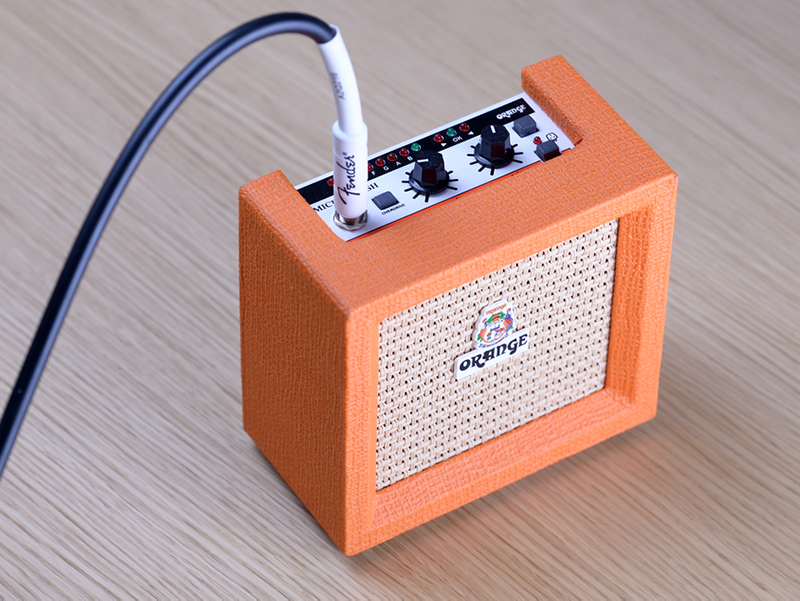
If you plan on playing with a drummer in your garage, so you're gonna need more muscle. A one-half-stack will dish out more enough oomph for your guitar to soar over the snares and cymbals. And while a total-stack is overkill, it's groovy for giving your drummer volume green-eyed.
Features
Most modern amps, fifty-fifty the tinier ones, are studded with a constellation of knobs, switches, jacks and buttons. While it may seem like the more the merrier, y'all don't desire to fork out extra for features y'all'll never employ. Look out for channels, congenital-in effects, inputs and outputs, and, equally discussed before, modeling functions.
Channels

Well-nigh amps have at least two channels—a make clean mode and an overdriven 1—with many bigger models upping the ante with several more. Some even let you tweak the voicings of individual channels. Only if you're simply later on sparkling cleans and saturated baloney, 2 channels are all you need. Better withal if each channel has defended equalizer ("Bass," "Mid" and "Treble") controls.
Effects
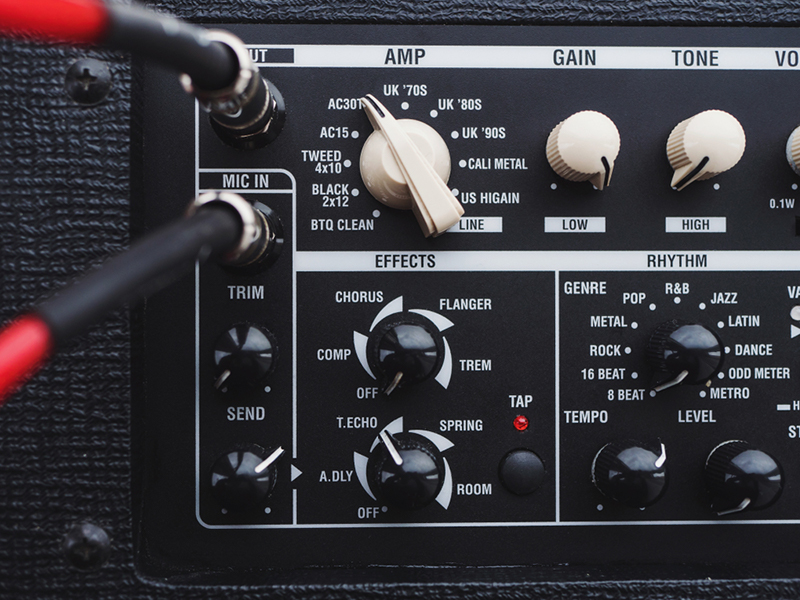
Reverb and chorus are mutual congenital-in furnishings on analog amps, while hybrid and digital ones can be equipped with dozens of furnishings both ordinary and outrageous. They're fun to toy around with, and they're useful introductions to the wild earth of pedals. Simply an onboard upshot won't sound as skillful as a defended bazaar stompbox—for at present, at least.
Inputs and outputs
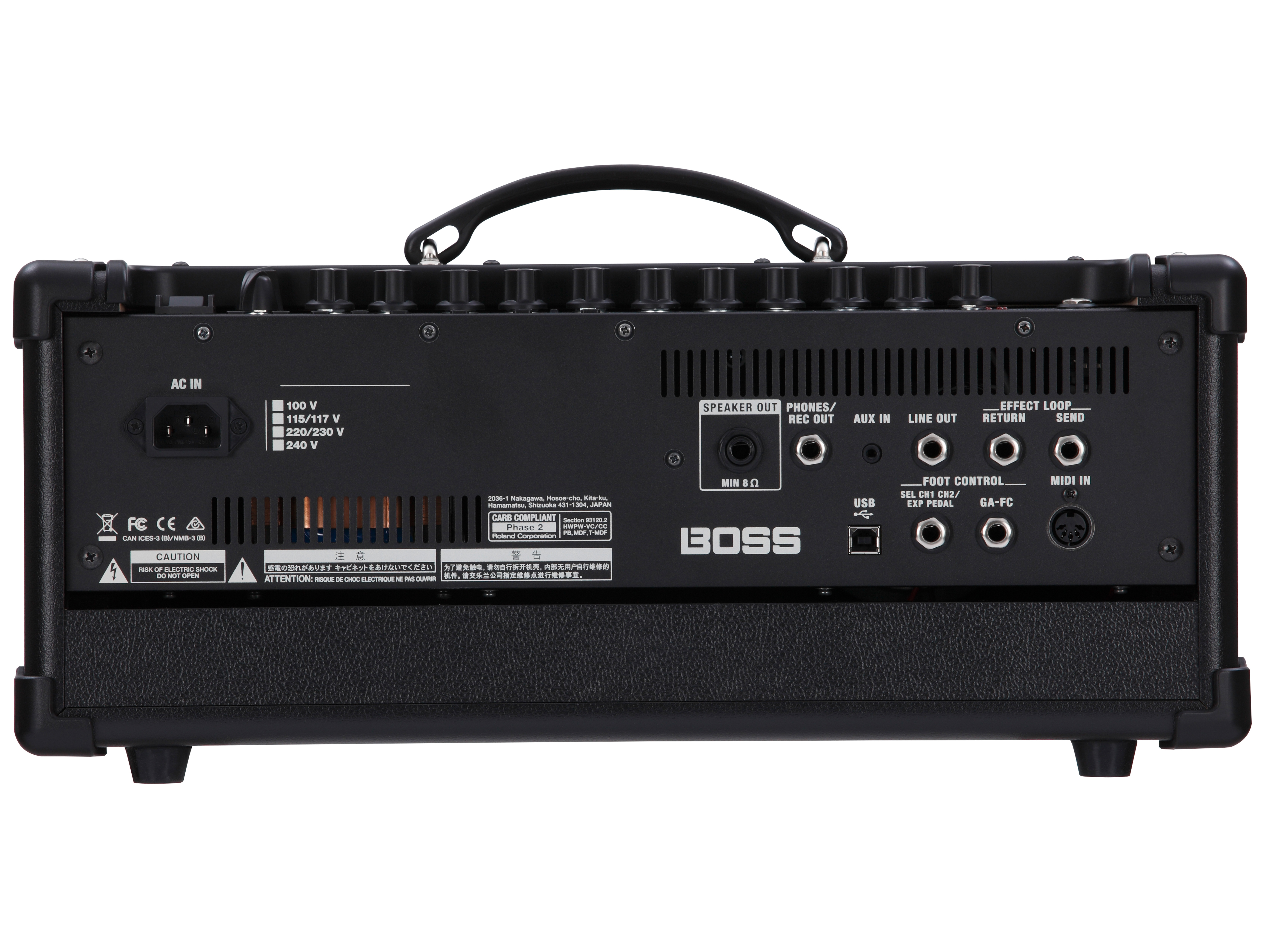
Peek at the back of an amplifier and you'll find input and output jacks of all sizes. This is where you'll hook upwardly other devices, such as a footswitch to command your onboard effects, external speakers for more might, and pedals to daisy-concatenation into an furnishings loop. Some models besides come with outputs for recording or for plugging into a mixer.
Now that y'all're armed with the vocabulary of guitar amplifiers, stay tuned for our recommended models. But for at present, go forth and make some dissonance.
mckinnonsaftessithe.blogspot.com
Source: https://guitar.com/guides/essential-guide/choose-buy-electric-guitar-amplifier/